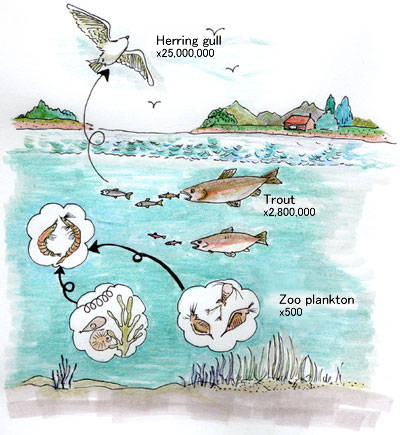| Have you ever heard of PCBs
(polychlorinated biphenyls)?
PCBs are chemicals that usually appear as a gummy transparent
liquid, like oil (see the illustration).

PCBs have very convenient features, such as electricity insulation,
acidity and alkaline resistance, and chemical stability. They
were once called "dream chemical substances," and were widely
used in pressure sensitive papers, the stabilizers of fluorescent
lights, transformers and condensers. However, it has been
discovered that PCBs are toxic to our bodies. It causes damage
to the liver and skin, and disrupts the functioning of the
nervous and immune systems.
 Moreover,
once PCBs are absorbed into one's body, they remain indefinitely
because of their chemical stability. If grass-eating animals
accumulate PCBs in their bodies, it then passes on to the
bodies of carnivores that eat them. There is a tendency for
PCBs to accumulate in higher concentrations in human beings
and carnivores, that is, creatures that are found at the top
of the food chain (See illustration: the food chain pyramid). Moreover,
once PCBs are absorbed into one's body, they remain indefinitely
because of their chemical stability. If grass-eating animals
accumulate PCBs in their bodies, it then passes on to the
bodies of carnivores that eat them. There is a tendency for
PCBs to accumulate in higher concentrations in human beings
and carnivores, that is, creatures that are found at the top
of the food chain (See illustration: the food chain pyramid).
PCBs are also passed onto children from their mothers. Children
are often sensitive to chemical substances and the impacts
of these substances on their lives are immeasurable. There
have been reports of massive deaths of wild animals attributed
to PCBs.
PCBs may also change form, from liquid to gas. Gases spread
globally and have even been found as far away as the North
and South Poles, places that have never seen the use of PCBs.
Once PCBs are emitted into the natural environment, they spread
widely and take an extremely long time to decompose.
We all have shared the benefits of PCBs. However, if we do
not take action, it will be our children, and future generations,
who have had nothing to do with PCB production and usage,
who face the detrimental consequences. We should not leave
negative legacies of the 20th century to future generations.
Putting an end to this problem within our generation is a
responsibility for the whole world.
Let's think about what we can do as citizens of the world,
by gaining more knowledge about PCBs from this CD. |
